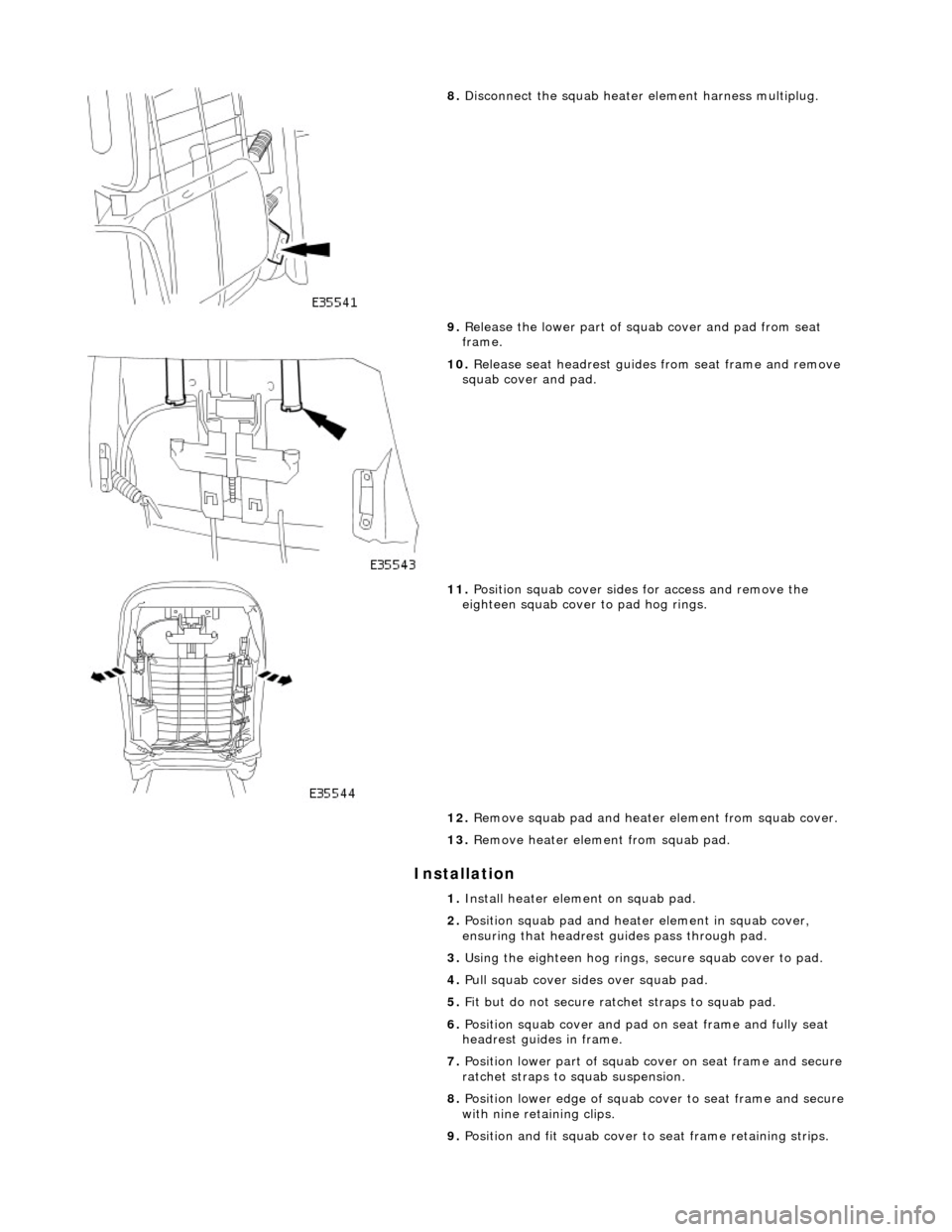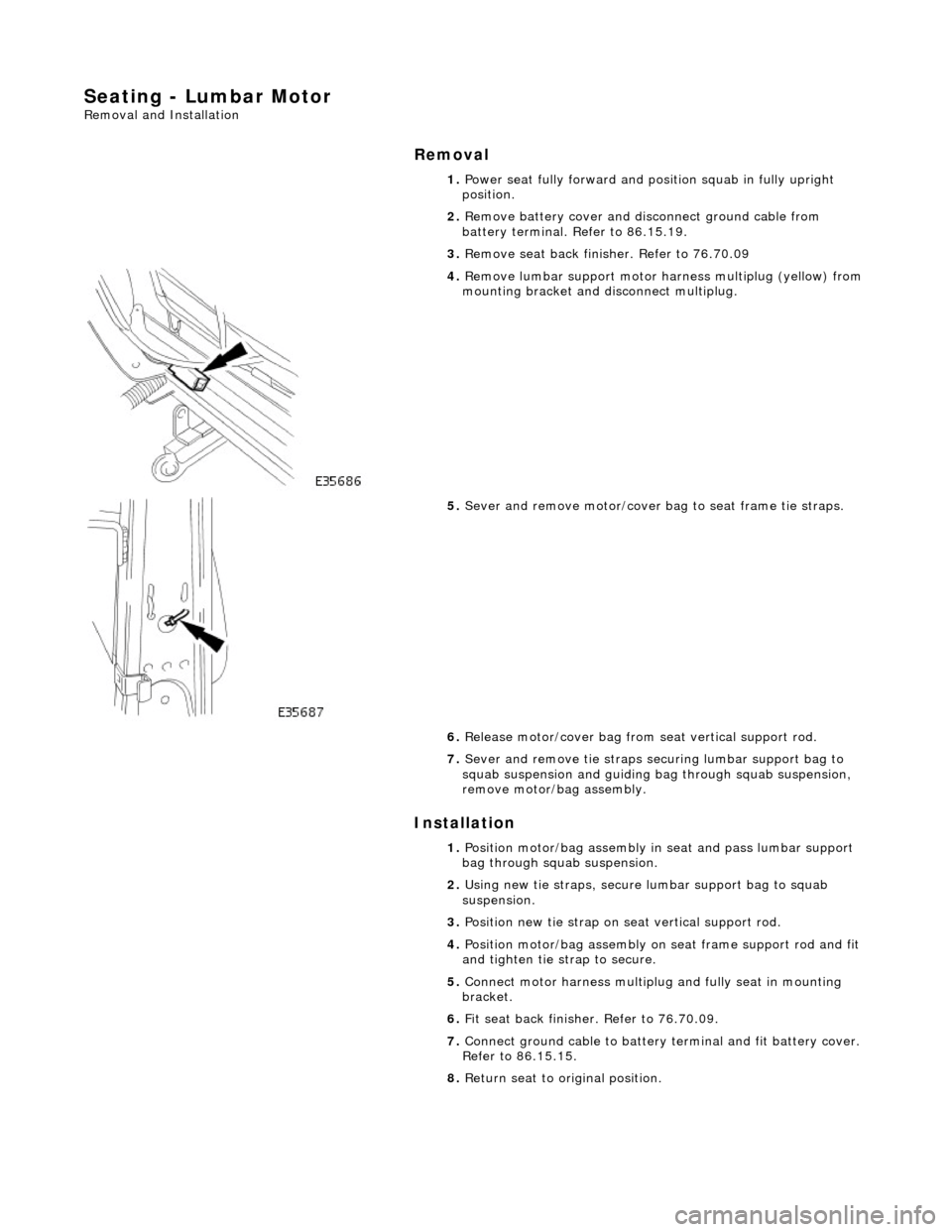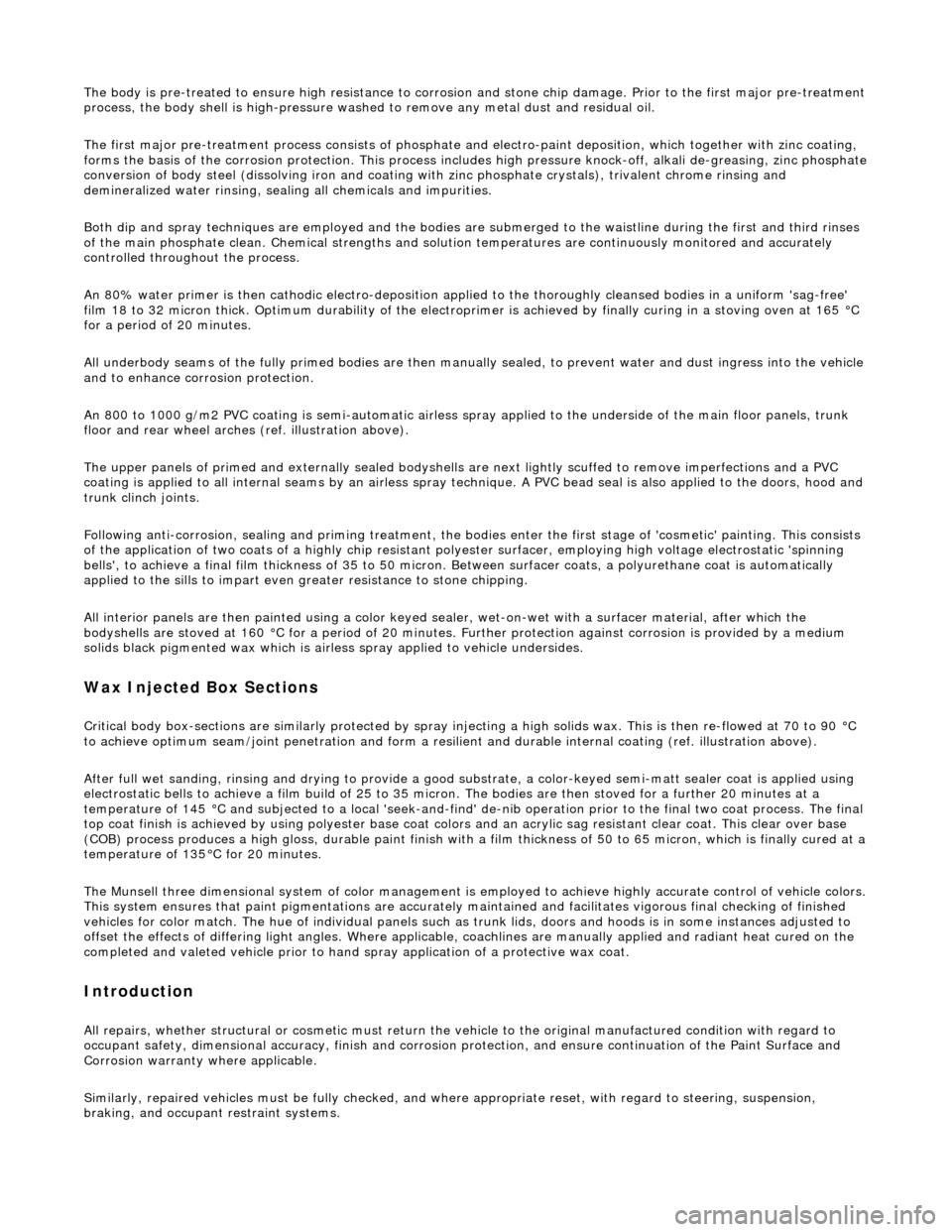Page 2125 of 2490

Installation
8. Disconnect the squab heater element harness multiplug.
9. Release the lower part of squab cover and pad from seat
frame.
10. Release seat headrest guides from seat frame and remove
squab cover and pad.
11. Position squab cover sides for access and remove the
eighteen squab cover to pad hog rings.
12. Remove squab pad and heater element from squab cover.
13. Remove heater element from squab pad.
1. Install heater element on squab pad.
2. Position squab pad and heater element in squab cover,
ensuring that headrest gu ides pass through pad.
3. Using the eighteen hog rings, secure squab cover to pad.
4. Pull squab cover sides over squab pad.
5. Fit but do not secure ratc het straps to squab pad.
6. Position squab cover and pad on seat frame and fully seat
headrest guides in frame.
7. Position lower part of squab co ver on seat frame and secure
ratchet straps to squab suspension.
8. Position lower edge of squab co ver to seat frame and secure
with nine retaining clips.
9. Position and fit squab cover to seat frame retaining strips.
Page 2127 of 2490
Seating - Front Seat Backrest Cover
Removal and Installation
Removal
1. WARNING: FOLLOWING DISCONNECTION OF THE
BATTERY A PERIOD OF AT LEAST ONE MINUTE MUST BE
ALLOWED TO ELAPSE BEFORE WORKING ON A FRONT SEAT WITH
A SIDE AIRBAG FITTED.
Remove battery cover and disc onnect ground cable from
battery terminal. Refer to 86.15.19.
2. Remove front seat for ac cess. Refer to 76.70.01.
3. Remove Seat back finisher. Refer to 76.70.09.
4. Remove front seat headrest.
5. Release the squab cover to seat frame securing strips (6 on
Vanden Plas models)
6. Release the squab cover to seat frame lower securing clips.
7. Remove the four squab pad to squab suspension hog rings.
8. On Vanden Plas models only, sever the two ratchet straps
securing squab pad to squab suspension.
Page 2129 of 2490
2.
Position squab pad and heater element in squab cover,
ensuring that headrest gu ides pass through pad.
3. Using the eighteen hog rings, secure squab cover to pad.
4. Puul squab cover sides over squab pad.
5. Fit but do not secure ratc het straps to squab pad.
6. Position squab cover and pad on seat frame and fully seat
headrest guides in frame.
7. Position lower part of squab co ver on seat frame and secure
ratchet straps to squab suspension.
8. Position lower edge of squab co ver to seat frame and secure
with nine retaining clips.
9. Position and fit squab cover to seat frame retaining strips.
10. Fit and tighten squab cover upper securing screws.
11. Fit headrest.
12. Fit seat back finisher. Refer to 76.70.09.
13. Install front seat in vehi cle. Refer to 76.70.01.
14. Connect ground cable to batt ery terminal and fit battery
cover. Refer to 86.15.15
Page 2135 of 2490
8. Detach cushion cover front elas tic retaining straps from seat
frame.
9. Remove seat cushion pad to cushion suspension hog rings.
10. Reposition cushion cover sides, lift and hold cushion pad for
access to rear of seat switch and disconnect harness multiplug.
11. Remove seat switch.
Release seat switchpack upper retaining tangs.
Release switchpack lower retaining tangs adjacent to seat
runners and remove switch.
Page 2154 of 2490

Seating - Lumbar Motor
Removal and Installation
Removal
Installation
1.
Power seat fully forward and position squab in fully upright
position.
2. Remove battery cover and disc onnect ground cable from
battery terminal. Refer to 86.15.19.
3. Remove seat back fini sher. Refer to 76.70.09
4. Remove lumbar support motor ha rness multiplug (yellow) from
mounting bracket and di sconnect multiplug.
5. Sever and remove motor/cover ba g to seat frame tie straps.
6. Release motor/cover bag from seat vertical support rod.
7. Sever and remove tie straps se curing lumbar support bag to
squab suspension and guiding bag through squab suspension,
remove motor/bag assembly.
1. Position motor/bag assembly in seat and pass lumbar support
bag through squab suspension.
2. Using new tie straps , secure lumbar support bag to squab
suspension.
3. Position new tie strap on se at vertical support rod.
4. Position motor/bag assembly on seat frame support rod and fit
and tighten tie st rap to secure.
5. Connect motor harness multiplug and fully seat in mounting
bracket.
6. Fit seat back finisher. Refer to 76.70.09.
7. Connect ground cable to battery terminal and fit battery cover.
Refer to 86.15.15.
8. Return seat to original position.
Page 2381 of 2490

The body is pre-treated to ensure high resistance to corrosion and stone chip dama ge. Prior to the first major pre-treatment process, the body shell is high-pressure washed to remove any metal dust and residual oil.
The first major pre-treatment process consists of phosphate and electro-paint deposition, which together with zinc coating,
forms the basis of the corrosion protection. This process includes high pressure knock-off, alkali de-greasing, zinc phosphate
conversion of body steel (dissolving iron and coating with zinc phosphate crystals), trivalent chrome rinsing and
demineralized water rinsing, seal ing all chemicals and impurities.
Both dip and spray techniques are employed and the bodies are submerged to the waistline during the first and third rinses
of the main phosphate clean. Chemical strengths and soluti on temperatures are continuously monitored and accurately
controlled throughout the process.
An 80% water primer is then cathodic elec tro-deposition applied to the thoroughly cleansed bodies in a uniform 'sag-free'
film 18 to 32 micron thick. Optimum durabi lity of the electroprimer is achieved by finally curing in a stoving oven at 165 °C
for a period of 20 minutes.
All underbody seams of the fully primed bo dies are then manually sealed, to prevent water and dust ingress into the vehicle
and to enhance corrosion protection.
An 800 to 1000 g/m2 PVC coating is semi-automatic airless sp ray applied to the underside of the main floor panels, trunk
floor and rear wheel arches (ref. illustration above).
The upper panels of primed and external ly sealed bodyshells are next lightly scuffed to remove imperfections and a PVC
coating is applied to all internal seams by an airless spray technique. A PVC bead seal is also applied to the doors, hood and
trunk clinch joints.
Following anti-corrosion, sealing and primin g treatment, the bodies enter the first stage of 'cosmetic' painting. This consists
of the application of two coats of a highly chip resistant po lyester surfacer, employing high voltage electrostatic 'spinning
bells', to achieve a final film thickness of 35 to 50 micron. Between surfacer coats, a polyurethane coat is automatically
applied to the sills to impart even greater resistance to stone chipping.
All interior panels are then painted us ing a color keyed sealer, wet-on-wet wi th a surfacer material, after which the
bodyshells are stoved at 160 °C for a period of 20 minutes. Further protection agai nst corrosion is provided by a medium
solids black pigmented wax which is airless spray applied to vehicle undersides.
Wax Injected Box Sections
Critical body box-sections are si milarly protected by spray injecting a high solids wax. This is then re-flowed at 70 to 90 °C
to achieve optimum seam/joint penetratio n and form a resilient and durable internal coating (ref. illustration above).
After full wet sanding, rinsing and drying to provide a good su bstrate, a color-keyed semi-matt sealer co at is applied using
electrostatic bells to achieve a film build of 25 to 35 micron . The bodies are then stoved for a further 20 minutes at a
temperature of 145 °C and subjected to a local 'seek-and-find' de -nib operation prior to the final two coat process. The final
top coat finish is achieved by using poly ester base coat colors and an acrylic sag resistant clear coat. This clear over base
(COB) process produces a high gloss, durabl e paint finish with a film thickness of 50 to 65 micron, which is finally cured at a
temperature of 135°C for 20 minutes.
The Munsell three dimensional system of color management is em ployed to achieve highly accurate control of vehicle colors.
This system ensures that paint pigmentations are accurately maintained and facilitates vigorous final checking of finished
vehicles for color match. The hu e of individual panels such as trunk lids, doors and hoods is in some instances adjusted to
offset the effects of differing light angles. Where applicable, coachlines are manually applied and radiant heat cured on the
completed and valeted vehicle prior to hand spray applic ation of a protective wax coat.
Introduction
All repairs, whether structural or cosmetic must return the vehicle to the original manufactured condition with regard to
occupant safety, dimensional accuracy, fi nish and corrosion protection, and ensure continuation of the Paint Surface and
Corrosion warranty where applicable.
Similarly, repaired vehicles must be fu lly checked, and where appropriate reset, with regard to steering, suspension,
braking, and occupant restraint systems.
Page 2387 of 2490
Key to Plan
Standard Wheelbase Body Dimensions- Side View
KeyLocation
1Front face body-bumper strut/mounting point
2Rearmost hole, vee-mount to crush tube
3Front Master Datum Plan, centre li ne of front crossmember rear mount ing at main floor RH longitudinal
4Rearmost hole, transmission mounting at main floor RH longitudinal
5Handbrake rear lever bracket fixings
6Rear Master Datum Plan, rear longitudinal
7Tapped boss, rear suspension 'A' frame mounting bush
8Rear suspension spring-pan damper mounting
9Rear suspension differential strut mounting
10Rear face body-bumper strut/mounting point
11Driveshaft centre bearing mounting
Page 2388 of 2490
Key to SideView
Long Wheelbase Body Dimensions-Plan
KeyLocation
1Front face body-bumper strut/mounting point
2Front Master Datum Vertical, centre line of front crossmember rear mounting
3Transmission mountings at the main floor longitudinal
4Handbrake rear lever bracket fixings
5Rear Master Datum Vertical,, rear longitudinal
6Tapped boss, rear suspensi on 'A' frame mounting bush
7Rear suspension spring-pan damper mounting
8Rear suspension differential strut mounting
9Rear face body-bumper strut/mounting point
10Wheel centre to bumper cover face
11Wheelbase
12Wheel Centre to Bumper Cover Face
13Driveshaft centre bearing mounting